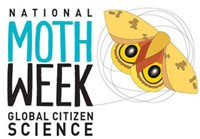
9th Annual Celebration
July 18-26,2020
Discover the Fascinating World of Moths in Your Backyard
Looking for an activity that’s safe, fun and enriching for all ages during this period of social distancing?
The ninth annual National Moth Week, July 18-26, invites novice and experienced “moth-ers,” alike, to observe these fascinating creatures in their own backyards and contribute to our scientific knowledge as part of one of the world’s largest citizen science projects.
While they’ve been maligned as butterflies’ less attractive and sometimes more destructive cousins, moths have always had loyal fans for their diversity, beauty and value as pollinators and food sources for birds and other animals. The beautiful Luna, mystifying Death’s-head and exotic tropical moths have long attracted the attention of artists and writers as well as entomologists.
As people likely will continue avoiding crowds this summer to slow the spread of COVID-19 infections, National Moth Week (NMW) offers the opportunity to learn about nighttime nature from the safety of backyards and gardens; porches, decks and terraces.
Free registration of private and public moth-watching events is encouraged on the NMW website in order to show where moths are being observed around the world. Private street addresses are never displayed. All participants will receive a beautiful certificate of participation designed by Ecuadorean artist Belen Mena of the NMW team.
“This year’s National Moth Week may not feature as many traditional public moth nights as in the past, but it’s still possible to observe and learn about moths while social distancing,” said Liti Haramaty, co-founder of National Moth Week. “All you need is an outdoor light source shining on a wall, door or white sheet. And don’t forget your camera.”
In addition to using lights, moth-ers also can attract moths by coating tree trunks with a sticky, sweet mixture of fruit and stale beer. Searching for caterpillars and day-flying moths is a good activity for daytime. The NMW website offers tips on attracting moths.
Participants are invited to contribute photos and data to NMW partner websites, as well as the NMW Flickr group, which now has over 100,000 moth photos from around the world. Moth observations submitted to iNaturalist.org, a site for sharing observations in the natural world, will be added to the NMW project on that site. Last year, over 27,000 moth observations were posted on iNaturalist.
Since it was established in 2012, NMW has inspired thousands of public and private moth-watching and educational events around the world in over 80 countries and all 50 U.S. states. Sites have included National Parks and Monuments, museums and local recreation areas, private backyards and front porches – wherever there’s a light and a place for them to land.
Last year, hundreds of National Moth Week events were registered around the world, including all 50 states and 47 countries.
“Moth diversity is astonishing and with a little effort it’s amazing what can be found in a backyard or local park,” said NMW co-founder David Moskowitz, Ph.D. “Some of my most exciting moth adventures have been in my own small backyard. Exploring yours is sure to yield moth treasures that are just waiting to be found.”
National Moth Week was founded by the Friends of the East Brunswick (N.J.) Environmental Commission, a nonprofit organization dedicated to environmental education and conservation. It is now one of the most widespread citizen science projects in the world. It is coordinated by volunteers in New Jersey, New York, Tennessee, Washington State, Ecuador, India and Hong Kong.
For more information about National Moth Week, visit the website at nationalmothweek.org, or write to info@nationalmothweek.org. Also, find National Moth Week on Facebook, Twitter (@moth_week) and Instagram (mothweek). #Nationalmothweek #mothweek
__________________________________________________________________________
Why study moths?
- Part of the Lepidoptera order of insects, moths are among the most diverse and successful organisms on earth.
- Scientists estimate there are 150,000 to more than 500,000 moth species.
- Their colors and patterns are either dazzling or so cryptic that they define camouflage. Shapes and sizes span the gamut from as small as a pinhead to as large as an adult’s hand.
- Most moths are nocturnal, and need to be sought at night to be seen – others fly like butterflies during the day.
- Finding moths can be as simple as leaving a porch light on and checking it after dark. Serious moth aficionados use special lights and baits to attract them.
###